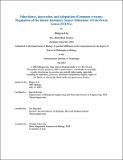Inheritance, innovation, and adaptation of immune systems: Regulation of the Innate Immunity Sensor Stimulator of Interferon Genes (STING)
Author(s)
Liu, Bingxu
DownloadThesis PDF (21.04Mb)
Advisor
Irvine, Darrell
Hacohen, Nir
Terms of use
Metadata
Show full item recordAbstract
The recognition and defense against pathogen invasion represent a common focus across various living systems. Recent advancements have shed light on the structural similarities observed in multiple innate immune proteins shared between bacteria and humans. These findings suggest the evolutionary origins of certain human innate immune genes from bacteria. Using the innate immune protein STING as an example, which exhibits conserved domains from bacteria to humans, we investigated how the activity of human STING is regulated both similarly and differently compared to its bacterial counterpart.
Similar to bacterial STING, the oligomerization of human STING is adequate to activate multiple downstream responses. However, unlike bacteria, the unique N-terminal transmembrane domain of human STING forms a proton channel, which plays a role in inducing non-canonical autophagy and inflammasome activation. Additionally, we demonstrated that mammalian cells employ DNAJC13 to prevent the accumulation of aggregated STING following its activation. This mechanism serves to avoid excessive activation of STING and ensure an appropriate response in mammalian cells. Our work, guided by evolutionary information, provides compelling experimental evidence for novel functions of STING and unveils new methods of regulating STING activity. These insights are valuable for guiding STINGbased therapies. Moreover, the innovative and adaptive nature of STING in mammalian cells offers new inspiration for engineering proteins derived from different hosts for diverse purposes.
Date issued
2023-09Department
Massachusetts Institute of Technology. Department of BiologyPublisher
Massachusetts Institute of Technology